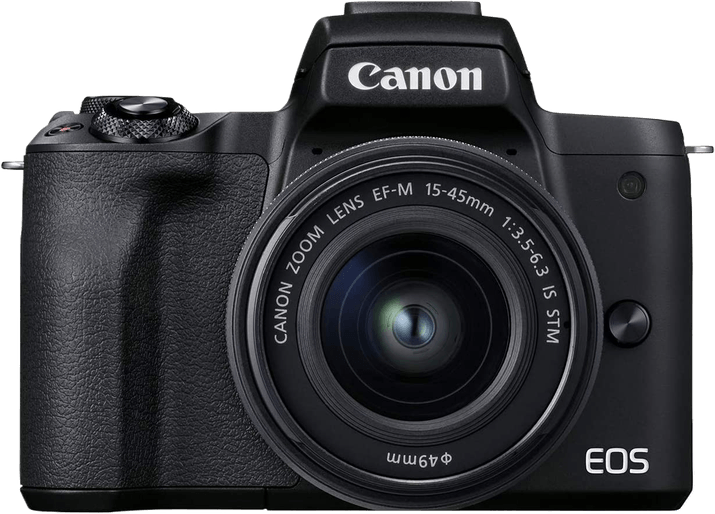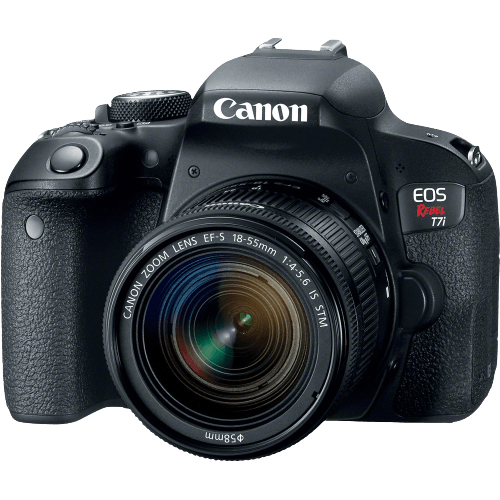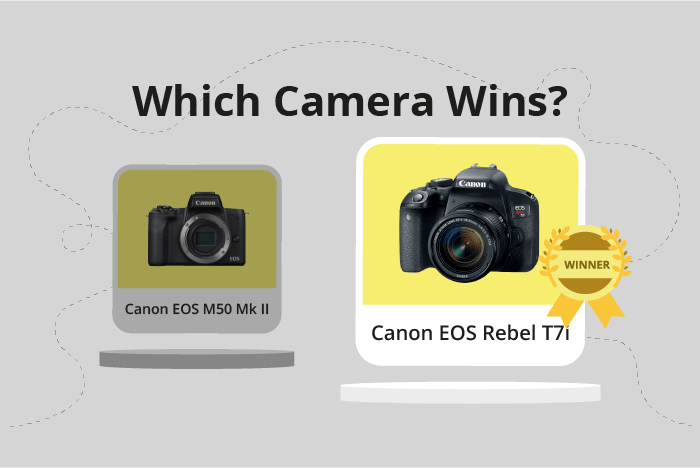Canon EOS M50 Mark II vs EOS Rebel T7i / 800D Comparison
Canon EOS M50 Mark II

Canon EOS Rebel T7i / 800D

The Canon EOS Rebel T7i / 800D secures the win with a score of 64/100, compared to the Canon EOS M50 Mark II‘s 59/100. Both cameras share similarities in their release years, 2017 and 2020, and their launch prices, $779 and $750, respectively.
The Rebel T7i, a DSLR, outperforms the M50 Mark II, a mirrorless camera, with its higher score. The Rebel T7i’s advantages include a more substantial build, measuring 131 x 100 x 76mm and weighing 532g, offering a more robust and durable feel.
On the other hand, the M50 Mark II shines in its compact size, measuring 116 x 88 x 59mm and weighing 387g, making it more portable and lightweight than the Rebel T7i. This feature is ideal for photographers who prioritize convenience and mobility.
Weighing the pros and cons of each camera, the Rebel T7i provides a better overall performance, while the M50 Mark II caters to those seeking a more compact option.
Canon EOS M50 Mark II vs EOS Rebel T7i / 800D Overview and Optics
The Canon EOS Rebel T7i / 800D outperforms the Canon EOS M50 Mark II in optics, scoring 64/100 compared to the M50 Mark II’s 59/100. Both cameras share common specifications, including 24-megapixel resolution, CMOS sensor type, APS-C sensor size, and the absence of image stabilization.
The Rebel T7i’s superior optics performance stems from its higher DXOMARK score for the sensor, which is 79 compared to the M50 Mark II’s 58. This difference indicates a better sensor quality in the Rebel T7i, providing improved image quality and better low-light performance. Additionally, the Rebel T7i uses the Canon EF/EF-S lens mount, offering a wider range of compatible lenses compared to the M50 Mark II’s Canon EF-M mount. This increased lens compatibility allows users to explore various shooting styles and situations.
On the other hand, the M50 Mark II has a faster shooting speed of 10 frames per second (fps) compared to the Rebel T7i’s 6 fps. This advantage makes the M50 Mark II more suitable for capturing fast-moving subjects and action photography. However, this single advantage does not outweigh the Rebel T7i’s superior sensor quality and lens compatibility.
Taking all factors into consideration, the Canon EOS Rebel T7i / 800D is the better choice in terms of optics performance due to its higher sensor score and broader lens compatibility. While the Canon EOS M50 Mark II offers faster shooting speed, it falls short in overall optics quality compared to the Rebel T7i.
Canon EOS M50 Mark II vs EOS Rebel T7i / 800D Video Performance
The Canon EOS M50 Mark II outperforms the Canon EOS Rebel T7i / 800D in video capabilities, scoring 91 out of 100 compared to the T7i’s 70. Both cameras share some common features, such as built-in time-lapse functionality, which is useful for capturing stunning time-lapse sequences.
The M50 Mark II excels in video quality, offering 4K resolution with a maximum video dimension of 3840 x 2160, while the T7i only provides Full HD resolution with a maximum video dimension of 1920 x 1080. The higher resolution of the M50 Mark II results in crisper and more detailed videos. Additionally, the M50 Mark II has a maximum video frame rate of 120fps, double that of the T7i’s 60fps. This allows the M50 Mark II to capture smoother slow-motion footage and better handle fast-moving subjects.
The T7i has no specific advantages over the M50 Mark II in terms of video capabilities. Its lower resolution and slower frame rate make it less suitable for those seeking high-quality video performance.
The Canon EOS M50 Mark II is the clear winner in this comparison, offering superior video quality and performance with its 4K resolution and 120fps frame rate. The T7i falls short in these aspects, making it less ideal for video enthusiasts. Users seeking a camera with strong video capabilities should opt for the M50 Mark II, while those who prioritize other features may still find value in the T7i.
Canon EOS M50 Mark II vs EOS Rebel T7i / 800D Features and Benefits
The Canon EOS M50 Mark II and the Canon EOS Rebel T7i / 800D both have a feature score of 70 out of 100, making them equal in this aspect. They share several common specifications, including a 3-inch screen size, 1,040,000-dot screen resolution, touchscreen functionality, flip screen, WIFI, and Bluetooth capabilities.
The Canon EOS M50 Mark II stands out due to its compact size and lighter weight, making it more portable and convenient for on-the-go photography. This camera is more suitable for those who prioritize a smaller form factor without compromising on features.
On the other hand, the Canon EOS Rebel T7i / 800D has an advantage in its integrated GPS functionality. This feature allows photographers to geotag their images, making it easier to organize and categorize photos based on location. This camera is ideal for those who frequently travel or enjoy outdoor photography and wish to document their journeys with precision.
Both cameras offer a solid set of features, and the choice between them depends on the user’s specific needs and preferences. The Canon EOS M50 Mark II is the better option for those who value portability and a compact design, while the Canon EOS Rebel T7i / 800D is more suitable for photographers who require GPS functionality for their work.
Canon EOS M50 Mark II vs EOS Rebel T7i / 800D Storage and Battery
The Canon EOS Rebel T7i/800D outperforms the Canon EOS M50 Mark II in storage and battery, scoring 29/100 compared to the M50 Mark II’s 21/100. Both cameras share similarities in their storage capabilities, as they each possess one memory card slot and accept SD, SDHC, and SDXC cards with UHS-I compatibility. However, the Rebel T7i/800D excels in battery life, providing 600 shots per charge, while the M50 Mark II only offers 305 shots. The T7i/800D uses an LP-E17 battery type, which contributes to its extended battery life.
Despite the difference in battery life, neither camera supports USB charging. The M50 Mark II utilizes an LP-E12 battery type, resulting in fewer shots per charge. Although it may not be the winner in this category, the M50 Mark II still provides an adequate battery life for casual photography sessions.
Considering the storage and battery aspects, the Canon EOS Rebel T7i/800D proves to be superior, offering a longer-lasting battery life for extended shooting sessions. Meanwhile, the Canon EOS M50 Mark II remains a suitable option for those who prioritize compactness and do not require extensive battery life.
Canon EOS M50 Mark II vs EOS Rebel T7i / 800D – Our Verdict
Are you still undecided about which camera is right for you? Have a look at these popular comparisons that feature the Canon EOS M50 Mark II or the Canon EOS Rebel T7i / 800D:

